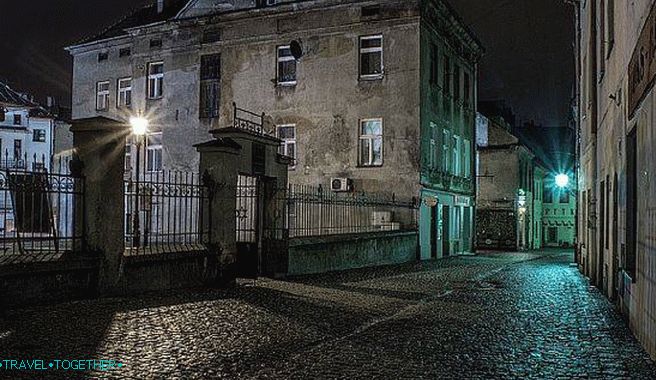Tarnow, Poland – detailed information with photos. Sights of Tarnów with description, history of the city and location on the map.
Tarnów is a city in the south of Poland, part of Malopolska province. The founding of the city dates back to the first half of the 14th century and dates back to the Piast era.
- Story
- sights
- City Information
The city of Tarnów is not only the unique beauty of the Old city, which preserved medieval streets, architectural masterpieces of gothic and renaissance. This is, first of all, a special spirit, which distinguishes the city from the rest of the region. Who was in Tarnów, he certainly felt his charm and atmosphere.
 Panorama Tarnów
Panorama Tarnów
For centuries, Tarnów was a refuge for immigrants: Jews, Germans, Ukrainians, Scots, Austrians, Czechs and others. And each new culture left its indelible mark on the “face” of the city. Here you find traces of the Italian Renaissance, immerse yourself in the atmosphere Jewish neighborhoods.
 Jewish quarters – night
Jewish quarters – night
City Information
- The population is more than 109 thousand people.
- Area – 72.4 km².
- Time – UTC + 1, in the summer UTC + 2.
- The language is Polish.
- The currency is Polish zloty.
City `s history
The history of Tarnów begins in 1330, when the settlement received city rights. The city was founded on a hill height of 226 meters, dominating all neighborhoods.
The medieval layout of the old Tarnów survived to our days The basis for the development of the city was its good location – at the crossroads of trade routes from Germany to Russia and from Hungary to coast of the Baltic Sea.
Tarnów remained a private city until 1787. And its dynamic development continued until the sixteenth century. In 1536 in the city there were 200 burgher houses, in which lived about 2 thousand. the inhabitants.
 Historical Center Tarnuva
Historical Center Tarnuva
Over the next 220 years (until the end of the 18th century) numerous fires, disasters, and then war and greed the owners destroyed and stopped the prosperity of Tarnów.
The city began to “revive” in 1787, when it became the residence bishops.
The nineteenth century turned the city into an industrial center.
At the end of October 1918, Tarnów was the first city in Poland to acquire freedom.
 Streets of Tarnów
Streets of Tarnów
World War II came to Tarnów on June 14, 1940, when from here went the first transport with prisoners to concentration camp Auschwitz
After World War II, Tarnów was a subordinate city. Krakow. In 1975, as a result of administrative reform, Tarnów became the center of the Tarnów Voivodeship, which was abolished in 1998 year The city has become an important administrative, economic, industrial and cultural center of the region.
Sights of Tarnów
The old town is the historical center of Tarnów, one of The main attractions of the city.
 Old city
Old city
The original historical layout has been preserved here. ancient buildings of the Gothic, Renaissance.
Jewish neighborhoods – the historical part of Tarnów, founded in the middle ages by Jewish communities. It houses buildings of the 17th and 18th centuries with a characteristic Jewish architecture, narrow aisles between houses and doors, containing excerpts from the Torah.
 Old jewish cemetery
Old jewish cemetery
The old Jewish cemetery begins its history from the 16th century and is the largest, oldest and most well-preserved in the south of Poland.
In the center of the district you can find the remains of an old synagogue. The only surviving fragment is the beam, the platform from which read the Torah.
 Centre Jewish quarters of Tarnów with remains of an old synagogue
Centre Jewish quarters of Tarnów with remains of an old synagogue
Basilica of the Mother of God – a monument of UNESCO, the most important Church Tarnów. The foundation of the church dates back to the year 1400. Height The tower is 72 meters.
 Basilica interior
Basilica interior
The basilica is famous for its renaissance tombstones that considered one of the most outstanding works of art in Poland. Representatives of Tarnovsky and Ostrogsky are buried in them. nobles
 Basilica Mother of God
Basilica Mother of God
Church “Our Lady of Mount Carmel” – a monument to UNESCO, wooden gothic church of the 16th century.

Church of sv. Trinity – a UNESCO Wooden Monument Gothic church of the late 16th century.

A painted village whose houses are painted in beautiful floral ornaments, the only one in Poland.
 Painted village
Painted village
Castle New Visnic – large defensive fortress, built in the first half of the 17th century. Consists of four double-decker wings grouped around a small inner the yard. The characteristic feature of the castle is the four corner. towers that look different.
 New Castle Vynich
New Castle Vynich
Fountain “Solar System” – located near train station. Made of glass and steel, the planet – granite. The rotation of celestial bodies occurs due to the action water.
Fountain “Solar System”
Water tower – steel construction height 37 meters and a tank of 3000 m3. Built in the 80s 20th century.
 Water pressure tower
Water pressure tower
Getz Palace – family residence, a large palace complex. Built in the 19th century. The complex is surrounded by 14 hectares of park in English style, in which a lot of nature monuments.
 Palace Getz
Palace Getz
Video about Tarnów






